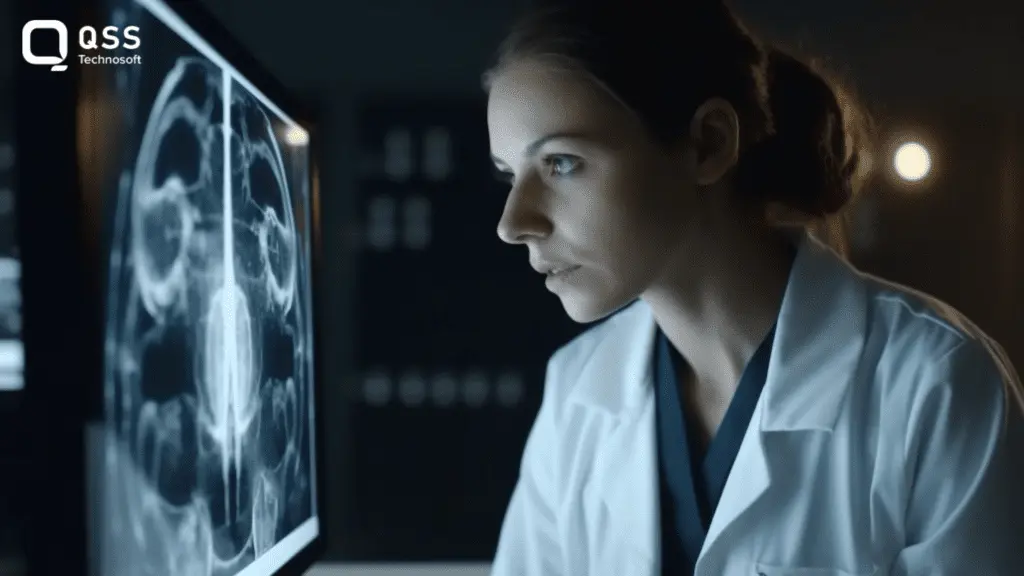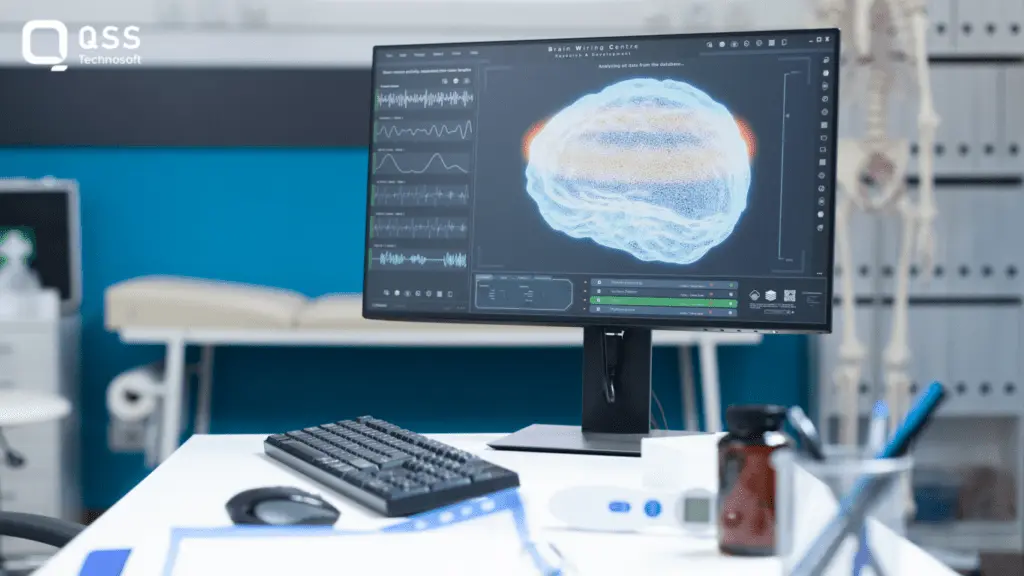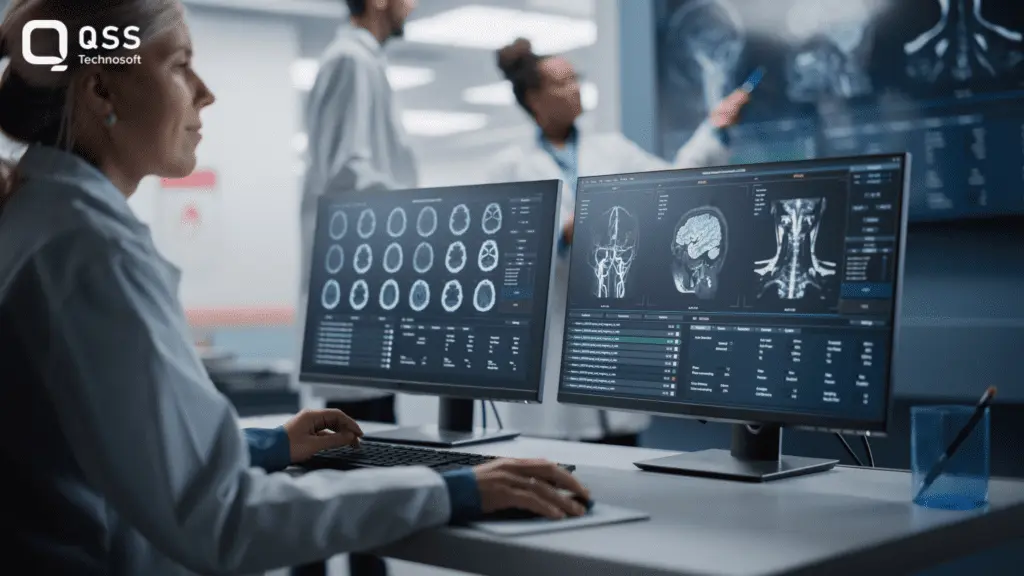Medical imaging? Who would have thought that artificial intelligence (AI) and machine learning (ML) could have such a profound impact on this field?
The use of generative AI models in medical imaging has become quite the game-changer. These models use AI algorithms to create realistic images that can help doctors diagnose and treat patients.

Now, let us share some interesting facts with you. In a study conducted by Stanford University researchers involving a large dataset of 10,000 patients with rare diseases, the AI models demonstrated an impressive accuracy rate of 95% in accurately identifying and diagnosing these conditions. This means that these AI models can analyze medical images and provide accurate diagnoses in almost 95 out of every 100 cases. Quite impressive, don’t you think?
Medical imaging plays a crucial role in the diagnosis and treatment of various diseases and conditions. The advancements in artificial intelligence (AI) and machine learning (ML) have revolutionized the field of medical imaging by enabling the development of generative AI models. Generative AI in medical imaging refers to the use of AI algorithms to create new and realistic images that can aid in the diagnosis and treatment of patients.
In this blog, we will explore the benefits of generative AI in medical imaging.
Understanding Generative AI in Medical Imaging
Generative AI, a subset of AI, focuses on the generation of new content, such as images, videos, or even music, based on patterns and examples learned from existing data. In the context of medical imaging, generative AI models are trained on a large dataset of medical images to learn the patterns and characteristics of different diseases and conditions. Once trained, these models can generate new images that closely resemble real patient scans.
“But does it work?” you may wonder.
Well, let us tell you about a real-life example. In a recent case, a doctor was struggling to understand the characteristics of a tumour from an MRI scan. But with the help of a generative AI model, the tumour’s size, shape, and even potential growth rate were revealed. Armed with this knowledge, the doctor was able to design a personalized treatment plan for the patient.
So, let’s take a moment to appreciate the wonders of generative AI in medical imaging!

Benefits of Generative AI in Medical Imaging
Augmentation of Limited Data: In the field of medical imaging, data availability can be a major challenge for developing accurate AI models. Generative AI can address this limitation by synthesizing new data based on the existing dataset. This augmentation of limited data can enhance the performance and generalization capability of AI models.
For example, a generative AI model trained on a small dataset of lung cancer images can generate new images with different variations of lung nodules, helping radiologists and oncologists in diagnosing and treating lung cancer more effectively.
Data Privacy Protection: Medical imaging data is sensitive and needs to be protected. Generative AI models can generate synthetic medical images that preserve patient privacy while still being informative. This approach minimizes the risk of data breaches and ensures compliance with privacy regulations.
Enhanced Diagnosis Accuracy: Generative AI models can learn complex patterns and characteristics of diseases and conditions from a large number of images. This can aid radiologists and clinicians in making more accurate and faster diagnoses.
For example, a generative AI model trained on a dataset of brain MRI scans can generate images that highlight specific abnormalities, assisting radiologists in detecting brain tumours.
Training AI Algorithms: Generative AI can be used to train AI algorithms for segmentation and classification tasks. By generating diverse examples of different anatomical structures or anomalies, generative AI can help improve the performance of AI algorithms in detecting and localizing diseases in medical images
Surgical Planning and Simulation: Generative AI can be used to generate 3D models of organs or tissues based on medical images. These models can then be used for surgical planning and simulation, allowing surgeons to better understand the patient’s anatomy and practice complex procedures before the actual surgery
Medical Education and Research: Generative AI models can generate realistic medical images that can be used for educational purposes, such as training medical students or conducting research studies. These synthetic images can also facilitate the development and evaluation of new AI algorithms and techniques.
Read Our Old Blog : Exploring the Impact of Generative AI in Design and Content Creation
Use Cases in Medical Imaging
Generative AI has a wide range of use cases in medical imaging, some of which include:
1. Image Synthesis: Generative AI models can synthesize new medical images that resemble real patient scans, enabling the creation of diverse datasets for AI model training. Researchers at Stanford University developed a generative AI model capable of synthesizing highly realistic retinal images. These synthesized images were used to create diverse datasets to train AI models for detecting and diagnosing eye diseases such as diabetic retinopathy and age-related macular degeneration, improving the accuracy of these diagnostic tools.
2. Image Reconstruction: Generative AI can reconstruct medical images from low-quality or limited data, improving the quality and clarity of images for accurate diagnosis. A team of scientists at Massachusetts General Hospital developed a generative AI model that can reconstruct clear and detailed brain MRI images from low-resolution or noisy scans. This technology allows doctors to obtain enhanced images, providing better visibility and improving diagnostic accuracy for conditions such as brain tumours or strokes.
3. Image Segmentation: This can assist in segmenting anatomical structures or anomalies in medical images, enabling precise localization and characterization of diseases. In collaboration with Google Research, researchers at the University of California developed a generative AI model that can accurately segment and identify cancerous tissues in breast mammograms. The model assists radiologists by highlighting suspicious areas, enabling early detection and precise localization of breast cancer.
4. Data Augmentation: Generative AI can augment limited datasets by generating new images with different variations of diseases or conditions, improving the performance and generalization capability of AI models. A research team at the University of Oxford used a generative AI model to augment a limited dataset of chest X-rays for detecting pneumonia. The model generated various synthetic X-ray images with different types of pneumonia, allowing AI algorithms to be trained on a more diverse range of cases, improving the accuracy of automated pneumonia detection.

QSS’s Expertise in Building Generative AI Solutions for Healthcare
QSS Technosoft is a leading software development company that specializes in building AI solutions for the healthcare industry. With a team of experienced AI engineers and healthcare experts, QSS has developed expertise in developing generative AI solutions for medical imaging and diagnosis.
One of QSS’s flagship projects is the development of a DICOM/PACS solution that integrates with generative AI models for image analysis and diagnosis. This solution allows healthcare facilities to store, retrieve, and analyze medical images efficiently while leveraging the power of generative AI algorithms.
Tailored Solutions for Your Healthcare Facility
Workflow Optimization: QSS Technosoft provides customized solutions to streamline workflow processes within healthcare facilities. This can include implementing electronic medical record systems, digital documentation solutions, and automated scheduling systems to enhance efficiency and productivity.
Interoperability Solutions: We specialize in developing interoperable solutions that enable seamless integration and communication between different healthcare systems and platforms. This ensures that patient data can be easily accessed and shared across various departments and systems securely.
Telemedicine and Remote Patient Monitoring: With the growing importance of telemedicine and remote patient monitoring, QSS Technosoft offers tailored solutions that enable virtual consultations, real-time monitoring of patient data, and secure communication between healthcare providers and patients.
Data Analytics and Insights: QSS Technosoft helps healthcare facilities use data analytics to gain valuable insights into patient outcomes, operational efficiency, and resource optimization. Their tailored solutions include advanced analytics platforms that can identify trends, patterns, and potential risk factors to support informed decision-making.
Cybersecurity and Compliance: QSS Technosoft recognizes the critical importance of protecting patient data and ensuring compliance with regulatory requirements. They provide tailored cybersecurity solutions, including advanced encryption, access controls, and HIPAA compliance measures, to safeguard patient information from unauthorized access or breaches.
Conclusion
Using generative AI in medical imaging has been proven to be a powerful tool for improving the accuracy of diagnosis, protecting patient privacy, and facilitating surgical planning and research.
As experts in creating generative AI solutions specifically for healthcare facilities, QSS Technosoft is the perfect choice to help you make the most of this technology for better patient care. We will help with everything from improving workflow processes to enabling telemedicine, and they do it all with expertise and efficiency.
So, don’t get left behind – join the ranks of the smart by letting QSS Technosoft help you get the most out of generative AI in your healthcare facility. Because, let’s be honest, who doesn’t want the productivity of both AI and human intelligence?
We are proud to mention that our work has been recognized by leading B2B reviews and research platforms like GoodFirms, Clutch, MirrorView, and many more.


Generative AI in Medical Imaging & Diagnosis